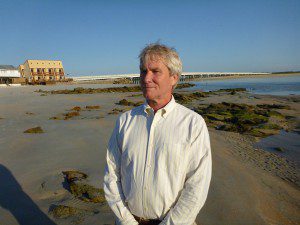This fall we’ve been looking at the ecosystem services provided by the various habitats, whether it’s the food it provides us or the protection they provide us from storm surge. Merely living near the coast and its natural habitats can be beneficial.
Dr. Randall Hughes FSU Coastal & Marine Lab
 I love the coast, and I especially love living along the coast. Seeing the ocean daily gives me a definite sense of peace, even when the water itself is not very peaceful. This good feeling appears to be shared by others – a study out of England found that people living near the coast reliably report that they are healthier than people of similar age, gender, etc., who live farther inland. The exact cause of this increased health (or increased feeling of health) isn’t entirely clear – it may be that people living along the coast are more physically active than their inland counterparts, or it may be that they have reduced stress levels. But the pattern suggests that there is a health benefit to living near the ocean.
I love the coast, and I especially love living along the coast. Seeing the ocean daily gives me a definite sense of peace, even when the water itself is not very peaceful. This good feeling appears to be shared by others – a study out of England found that people living near the coast reliably report that they are healthier than people of similar age, gender, etc., who live farther inland. The exact cause of this increased health (or increased feeling of health) isn’t entirely clear – it may be that people living along the coast are more physically active than their inland counterparts, or it may be that they have reduced stress levels. But the pattern suggests that there is a health benefit to living near the ocean.
Of course there are myriad reasons that people live near the coast, including job opportunities, abundant natural resources, culture, and climate. I’m thankful that my career as a marine ecologist ensures that I will always live somewhat near the ocean! And I am certainly not alone. Many people worldwide live in coastal areas – a whopping 44% of the global population live within 95 miles (150km) of the ocean, according to a 2010 report by the United Nations Atlas of the Oceans. That’s 44% of 6.8 billion people, and that’s a lot!
And herein lies something of a dilemma – how can we ensure that people can live near the coast and take advantage of the many economic and personal benefits of coastal ecosystems without harming the ecosystems themselves and losing those benefits? Or the even more vexing problem of one group of people taking advantage of the ecosystems and causing OTHER PEOPLE to lose the benefits of those ecosystems? (We don’t have to go far for an example of this latter issue – just think of the effects of upstream water diversions in the Apalachicola River system on the downstream oyster fishermen.)
 That’s when we need good, creative, dedicated people. People who work to strike a balance between the desire to develop coastal areas with the need to preserve and conserve these same areas. People like Pat Hamilton, featured in the video. Because if you don’t protect coastal ecosystems like oyster reefs, marshes, and seagrass beds, then you can lose a lot of the benefits that we derive from the coast, including productive fisheries, outdoor recreational opportunities, erosion control, storm protection, and water quality. And if you do protect them, you can even increase the value of the surrounding areas – for instance, a study by researchers at North Carolina State University found that homes in urban areas that were within 1/2 a mile to a wildlife refuge were worth 7-9% more than homes away from these wilderness areas.
That’s when we need good, creative, dedicated people. People who work to strike a balance between the desire to develop coastal areas with the need to preserve and conserve these same areas. People like Pat Hamilton, featured in the video. Because if you don’t protect coastal ecosystems like oyster reefs, marshes, and seagrass beds, then you can lose a lot of the benefits that we derive from the coast, including productive fisheries, outdoor recreational opportunities, erosion control, storm protection, and water quality. And if you do protect them, you can even increase the value of the surrounding areas – for instance, a study by researchers at North Carolina State University found that homes in urban areas that were within 1/2 a mile to a wildlife refuge were worth 7-9% more than homes away from these wilderness areas.
Our region of the Big Bend of Florida is unique in that significant tracts of undeveloped coastal areas remain. As people continue to discover all that this region has to offer and the desire to develop the coast increases, I hope that David and my research will help inform ways to strike that balance between both using and protecting important coastal ecosystems.
In the Grass, On the Reef is funded by the National Science Foundation.
